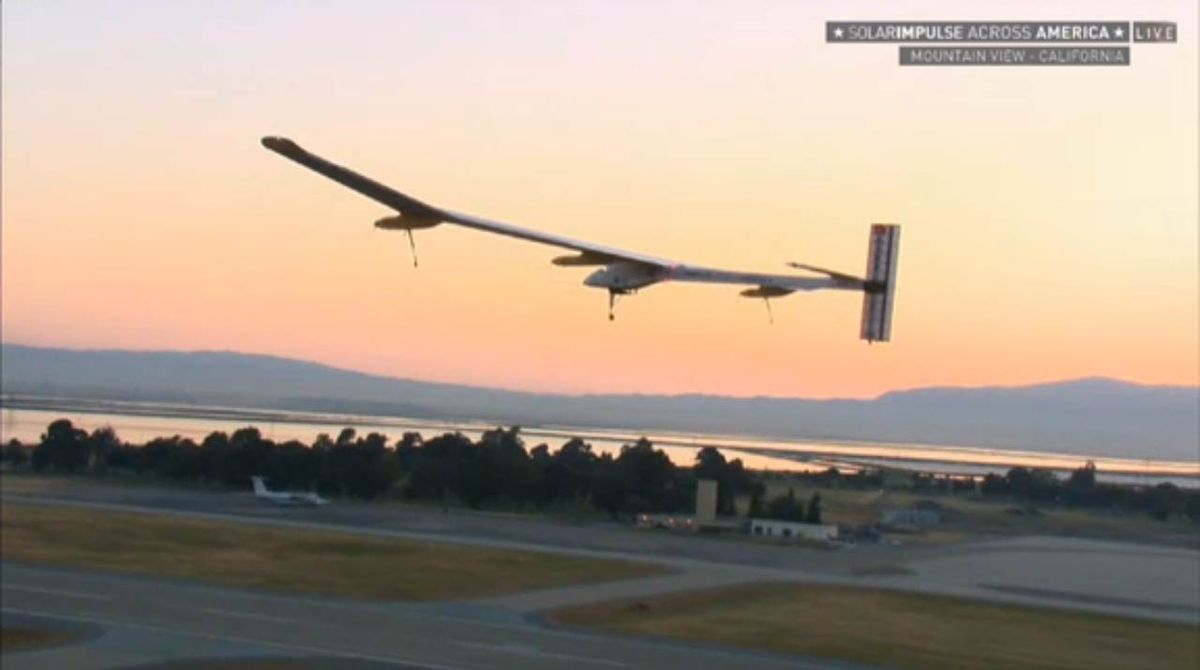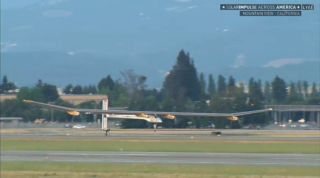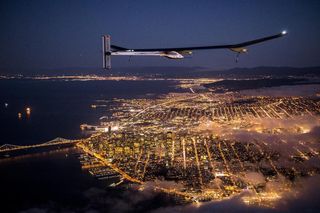Solar Plane's Pilot Describes 'Revolutionary' Flight

Nearly 15 years after he completed the first non-stop balloon trip around the world, Bertrand Piccard has not lost his appetite for adventure. The Swiss explorer embarked on the first leg of a coast-to-coast flight across the United States today (May 3) in a solar-powered airplane that can fly day or night without using any fuel.
The plane, called Solar Impulse, is on the first stretch of a months-long journey that will take it from California to New York as part of a campaign to promote solar technology and renewable energy.
Piccard departed from Moffett Airfield in Mountain View, Calif., this morning at 9:12 a.m. EDT (6:12 a.m. PDT). The Solar Impulse plane, which has a cruising speed of about 53 mph (85 km/h), is expected to land at Phoenix's Sky Harbor International Airport on Saturday (May 4) at 4:00 a.m. EDT (1:00 a.m. PDT), after 19 hours in the air. [Images: Cross-Country Flight in a Solar-Powered Plane]
For Piccard, being able to make the cross-country flight with zero fuel has been a decade-long dream.
"We want to promote the clean technologies that are so important for our world," Piccard told LiveScience from the cockpit of Solar Impulse, as the plane flew over Fresno, Calif., at an altitude of 12,000 feet (3,650 meters). "This is an exciting vision."

An airplane powered by the sun
As it flies, the ultra-lightweight aircraft collects energy from its solar panels, which span the full length of the plane's wings. This energy is also stored in onboard batteries, which enable the plane to fly during cloudier conditions, as well as through the night.
Sign up for the Live Science daily newsletter now
Get the world’s most fascinating discoveries delivered straight to your inbox.
Since the plane is so light, Piccard said it is extra sensitive, which requires him to maintain tight control of the aircraft throughout the flight.
Still, Piccard said flying for 19 hours straight is not as challenging as it may sound, and the aircraft can actually endure much longer flights.
"Theoretically, you can fly forever with the airplane," Piccard said. "But, of course, the pilot has no way to rest — no toilets, no autopilot — which means when the pilot is too tired, after 20 or 24 hours, it is safer to land."
Piccard and Solar Impulse co-founder André Borschberg will alternate piloting the single-seater plane on its cross-country trip. The journey has been broken down into five legs, with stops in Phoenix, Dallas, St. Louis, Washington, D.C., and wrapping up in New York City.
Each leg of the Solar Impulse expedition will be streamed live, with a video feed that includes information on the airplane's position, altitude and speed, as well as camera views from inside the cockpit and from Solar Impulse's mission control center in Switzerland. [WATCH LIVE: Streaming Video of the Solar Impulse Flight]
For Piccard, the inspiration for Solar Impulse came to him shortly after he circumnavigated the globe in 1999 in a gas-powered balloon. To complete that record-setting trip, he had to burn roughly 3.7 tons of liquid propane.
"I promised the next [time] I would fly around the world, or across the country, it would be with no fuel at all," Piccard said.

Spreading the message
Solar Impulse's cross-country trip is part of an initiative called "Clean Generation," which aims to promote clean technology efforts around the world. The program already has several high-profile backers, including Hollywood director James Cameron, former Apollo astronaut Buzz Aldrin, environmentalist and former U.S. Vice president Al Gore, and British entrepreneur Richard Branson.
The goal, however, is to increase support for the initiative throughout Solar Impulse's coast-to-coast flight. People can sign up on the Solar Impulse website to join the movement, and the names of all supporters are being carried on the plane as virtual passengers on a USB drive.
Piccard hopes to add more and more names to the list at each stopover city on Solar Impulse's cross-country trip.
"When we take off from Phoenix to Dallas, I hope we will have even more people," he said.
While Piccard said the technology is not advanced enough yet for commercial flights in the near future, Solar Impulse's cross-country jaunt demonstrates the enormous potential for using solar technology (and other renewable energy sources) in other aspects of our everyday lives, such as powering office buildings or homes.
As Piccard flew south over California, he marveled at the views of mountains and farmlands outside his cockpit window. And even with roughly 12 hours of flying time still ahead of him, he expects the experience will remain exhilarating.
"It's never boring, because it's the most revolutionary airplane that exists — an airplane that flies day or night with no fuel," Piccard said. "It's a privilege to fly it."
Follow Denise Chow on Twitter @denisechow. Follow LiveScience @livescience, Facebook & Google+. Original article on LiveScience.com.

Denise Chow was the assistant managing editor at Live Science before moving to NBC News as a science reporter, where she focuses on general science and climate change. Before joining the Live Science team in 2013, she spent two years as a staff writer for Space.com, writing about rocket launches and covering NASA's final three space shuttle missions. A Canadian transplant, Denise has a bachelor's degree from the University of Toronto, and a master's degree in journalism from New York University.









